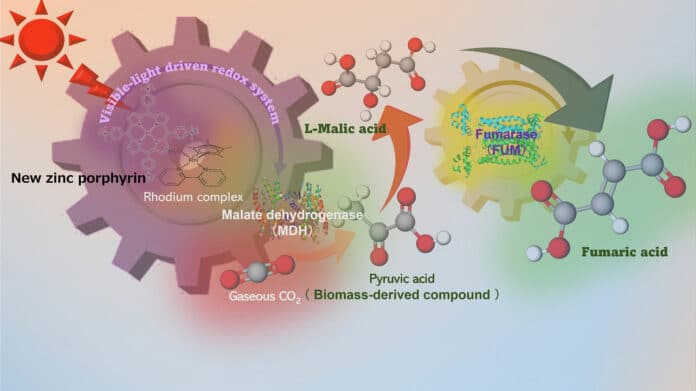Fumaric acid is a versatile dicarboxylic acid that’s often used as a precursor for biodegradable plastics like poly(butylene succinate) and poly(propylene fumarate), which have potential applications in medicine and packaging.
However, most of the fumaric acid produced today comes from non-renewable sources like benzene, which is derived from fossil fuels. This makes it essential to find more sustainable ways to produce fumaric acid, like using renewable resources from biomass.
Now, researchers at Osaka Metropolitan University have made significant progress in the sustainable production of fumaric acid, a key ingredient of biodegradable plastics. They developed a new environmentally friendly system that enables a simple biocatalytic fumaric acid production from renewable resources, carbon dioxide, and biomass-derived materials such as pyruvic acid.
The researchers were able to produce fumaric acid, which is normally obtained from petroleum, efficiently. This innovative and more efficient way to produce fumaric acid reduces carbon dioxide emissions, and reuses waste resources to make biodegradable plastics.
Previously, the researchers led by Professor Yutaka Amao from the Research Center for Artificial Photosynthesis at Osaka Metropolitan University had shown that they could synthesize fumaric acid from bicarbonate and pyruvic acid, a compound derived from biomass, using solar energy. They also achieved the production of fumaric acid from carbon dioxide taken directly from the gas phase as a raw material. However, the fumaric acid yield was still low.
In their recent study, researchers have now designed a new photosensitizer and advanced artificial photosynthesis technique that reportedly doubled the yield of fumaric acid compared to conventional methods. This could potentially have a significant impact on the production of biodegradable plastics and help address issues of plastic pollution and climate change.
“This is an extremely important advancement for the complex bio/photocatalyst system. It is a valuable step forward in our quest to synthesize fumaric acid from renewable energy sources with even higher yields, steering us toward a more sustainable future,” said Professor Amao in a statement.
Journal reference:
- Mika Takeuchia and Yutaka Amao. An effective visible-light-driven fumarate production from gaseous CO2 and pyruvate by the cationic zinc porphyrin-based photocatalytic system with dual biocatalysts. Dalton Transactions, 2023; DOI: 10.1039/D3DT03492E
